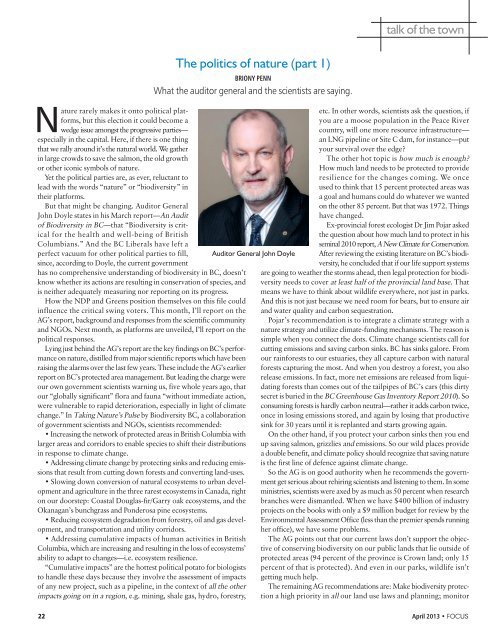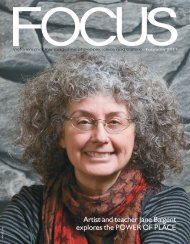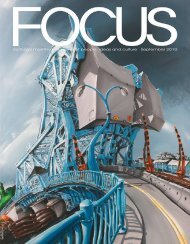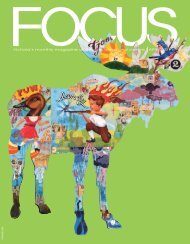Create successful ePaper yourself
Turn your PDF publications into a flip-book with our unique Google optimized e-Paper software.
talk of the townNature rarely makes it onto political platforms,but this election it could become awedge issue amongst the progressive parties—especially in the capital. Here, if there is one thingthat we rally around it’s the natural world. We gatherin large crowds to save the salmon, the old growthor other iconic symbols of nature.Yet the political parties are, as ever, reluctant tolead with the words “nature” or “biodiversity” intheir platforms.But that might be changing. Auditor GeneralJohn Doyle states in his March report—An Auditof Biodiversity in BC—that “Biodiversity is criticalfor the health and well-being of BritishColumbians.” And the BC Liberals have left aperfect vacuum for other political parties to fill,since, according to Doyle, the current governmenthas no comprehensive understanding of biodiversity in BC, doesn’tknow whether its actions are resulting in conservation of species, andis neither adequately measuring nor reporting on its progress.How the NDP and Greens position themselves on this file couldinfluence the critical swing voters. This month, I’ll report on theAG’s report, background and responses from the scientific communityand NGOs. Next month, as platforms are unveiled, I’ll report on thepolitical responses.Lying just behind the AG’s report are the key findings on BC’s performanceon nature, distilled from major scientific reports which have beenraising the alarms over the last few years. These include the AG’s earlierreport on BC’s protected area management. But leading the charge wereour own government scientists warning us, five whole years ago, thatour “globally significant” flora and fauna “without immediate action,were vulnerable to rapid deterioration, especially in light of climatechange.” In Taking Nature’s Pulse by Biodiversity BC, a collaborationof government scientists and NGOs, scientists recommended:• Increasing the network of protected areas in British Columbia withlarger areas and corridors to enable species to shift their distributionsin response to climate change.• Addressing climate change by protecting sinks and reducing emissionsthat result from cutting down forests and converting land-uses.• Slowing down conversion of natural ecosystems to urban developmentand agriculture in the three rarest ecosystems in Canada, righton our doorstep: Coastal Douglas-fir/Garry oak ecosystems, and theOkanagan’s bunchgrass and Ponderosa pine ecosystems.• Reducing ecosystem degradation from forestry, oil and gas development,and transportation and utility corridors.• Addressing cumulative impacts of human activities in BritishColumbia, which are increasing and resulting in the loss of ecosystems’ability to adapt to changes—i.e. ecosystem resilience.“Cumulative impacts” are the hottest political potato for biologiststo handle these days because they involve the assessment of impactsof any new project, such as a pipeline, in the context of all the otherimpacts going on in a region, e.g. mining, shale gas, hydro, forestry,The politics of nature (part 1)BRIONY PENNWhat the auditor general and the scientists are saying.Auditor General John Doyleetc. In other words, scientists ask the question, ifyou are a moose population in the Peace Rivercountry, will one more resource infrastructure—an LNG pipeline or Site C dam, for instance—putyour survival over the edge?The other hot topic is how much is enough?How much land needs to be protected to provideresilience for the changes coming. We onceused to think that 15 percent protected areas wasa goal and humans could do whatever we wantedon the other 85 percent. But that was 1972. Thingshave changed.Ex-provincial forest ecologist Dr Jim Pojar askedthe question about how much land to protect in hisseminal 2010 report, A New Climate for Conservation.After reviewing the existing literature on BC’s biodiversity,he concluded that if our life support systemsare going to weather the storms ahead, then legal protection for biodiversityneeds to cover at least half of the provincial land base. Thatmeans we have to think about wildlife everywhere, not just in parks.And this is not just because we need room for bears, but to ensure airand water quality and carbon sequestration.Pojar’s recommendation is to integrate a climate strategy with anature strategy and utilize climate-funding mechanisms. The reason issimple when you connect the dots. Climate change scientists call forcutting emissions and saving carbon sinks. BC has sinks galore. Fromour rainforests to our estuaries, they all capture carbon with naturalforests capturing the most. And when you destroy a forest, you alsorelease emissions. In fact, more net emissions are released from liquidatingforests than comes out of the tailpipes of BC’s cars (this dirtysecret is buried in the BC Greenhouse Gas Inventory Report 2010). Soconsuming forests is hardly carbon neutral—rather it adds carbon twice,once in losing emissions stored, and again by losing that productivesink for 30 years until it is replanted and starts growing again.On the other hand, if you protect your carbon sinks then you endup saving salmon, grizzlies and emissions. So our wild places providea double benefit, and climate policy should recognize that saving natureis the first line of defence against climate change.So the AG is on good authority when he recommends the governmentget serious about rehiring scientists and listening to them. In someministries, scientists were axed by as much as 50 percent when researchbranches were dismantled. When we have $400 billion of industryprojects on the books with only a $9 million budget for review by theEnvironmental Assessment Office (less than the premier spends runningher office), we have some problems.The AG points out that our current laws don’t support the objectiveof conserving biodiversity on our public lands that lie outside ofprotected areas (94 percent of the province is Crown land; only 15percent of that is protected). And even in our parks, wildlife isn’tgetting much help.The remaining AG recommendations are: Make biodiversity protectiona high priority in all our land use laws and planning; monitor22 April 2013 • FOCUS
















